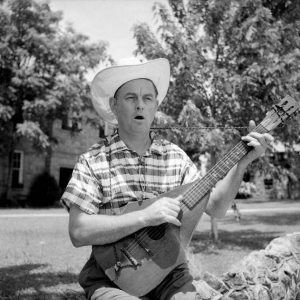calsfoundation@cals.org
The Amazing Adventures of My Dog Sheppy
In a 1958 effort to promote economic development and tourism in Stone County, a group of local investors under the leadership of Harold M. Sherman filmed a thirty-minute television pilot titled, “The Amazing Adventures of My Dog Sheppy.” A poor script, inept casting, amateurish acting, and the on-camera killing of a bobcat combined to produce a show that could not be pitched to the national networks. The film is significant, however, for documenting Stone County before the Ozark Folk Center or Blanchard Springs Caverns opened to the public.
The television pilot was the brainchild of Harold Sherman. This Michigan native was the author of more than sixty books, a motivational speaker, and a Hollywood script writer.
In 1958, television shows involving dogs drew large audiences. Sherman, who had written many scripts in his Hollywood days, worked with his friend Al Pollard, an advertising executive in Little Rock (Pulaski County), to write the script for something similar and then set up Mountain View Productions. A production budget of $20,000 was raised from investors in Mountain View (Stone County) and nearby Batesville (Independence County). Dan Milner of Milner Brothers Productions in Hollywood was hired as director and producer.
The script involved a little girl getting lost in the mountains and being saved by a beautiful white German shepherd—and an equally beautiful female archer who dramatically killed a bobcat that was supposed to be threatening the girl. The archer was Ann P. Marston, the reigning female archer in the country. The male lead was Robert Roark, a minor television and stage actor from Hollywood, who played a game warden. Billy Conner, a nine-year-old boy from Batesville, played the role of Sheppy’s master, and after winning a newspaper-sponsored contest, nine-year-old Meredith Lee Ross of Little Rock played the role of the lost girl. Folk musician Jimmy Driftwood was given a cameo role as Uncle Orie. Stone County sheriff Cullen Storey had a few lines of dialogue.
Sherman, a friend and supporter of Governor Orval Faubus, received substantial assistance from the state. Faubus hosted a press event in Little Rock on January 29, 1958, to publicize the film, with Marston performing some archery tricks. On hand to “sign” his contract with a paw print was the German shepherd “Kelly,” probably the most experienced actor in the production. Faubus also encouraged the Arkansas Game and Fish Commission to trap nine bobcats for use in the film.
Filming on site in Stone County got off to a poor start in early May 1958, with heavy rains followed by hot, humid conditions. Filming took little more than a week. Sherman went to Hollywood to assist with editing the film, and he seemed enthusiastic at first, telling the Stone County Leader that “an expert in the field says that it is equal to if not superior to the Lassie series.”
Sherman’s hopes were soon dashed by advisors in Hollywood, who believed the pilot would not be of interest to a sponsor. Sherman placed most of the blame on Milner Brothers Productions, claiming they had not adequately rehearsed the cast. He also mentioned that the casting was poor, and that the killing of the bobcat would not be acceptable.
On July 25, 1958, the pilot showed at the Melba Theater in Batesville, the only public showing it received. Sherman continued to promote the idea of filming a TV pilot in Stone County, but he was never successful in doing so. The original film is now part of the archival collections at the University of Central Arkansas (UCA) Torreyson Library in Conway (Faulkner County).
For additional information:
Dillard, Tom W. “Ozark Innovator’s Shaggy-Dog TV Pilot Didn’t Fly.” Arkansas Democrat-Gazette. August 13, 2006, p. 5H.
Harold M. Sherman Papers. University of Central Arkansas Archives and Special Collections, Conway, Arkansas.
Tom W. Dillard
University of Arkansas Libraries
 Arts, Culture, and Entertainment
Arts, Culture, and Entertainment World War II through the Faubus Era, 1941 through 1967
World War II through the Faubus Era, 1941 through 1967 Jimmy Driftwood
Jimmy Driftwood 



Comments
No comments on this entry yet.